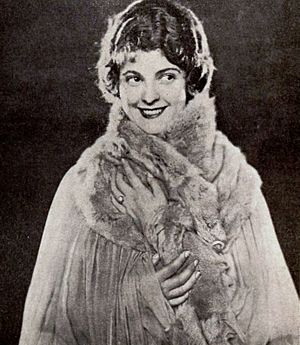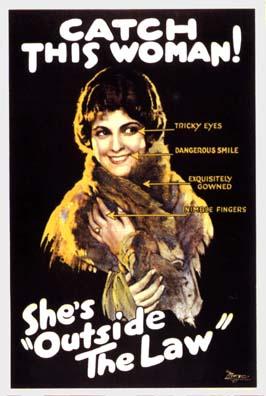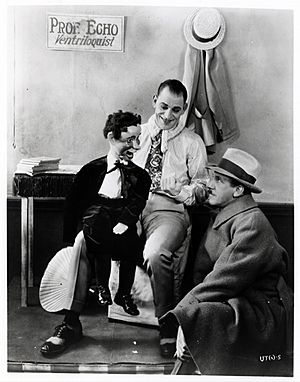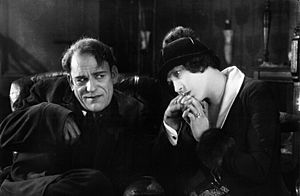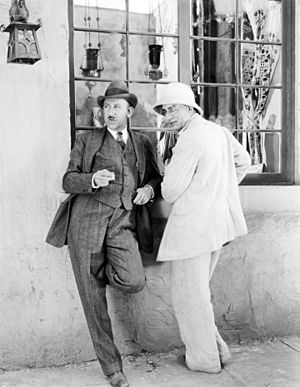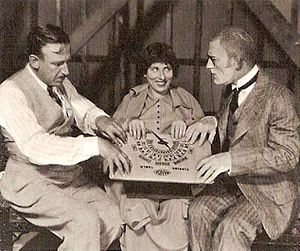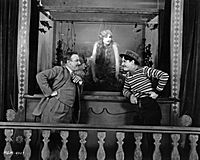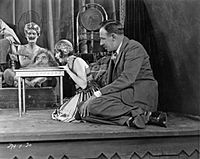Tod Browning facts for kids
Quick facts for kids
Tod Browning
|
|
|---|---|
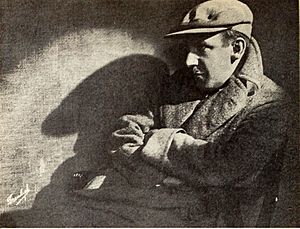 |
|
| Born |
Charles Albert Browning Jr.
July 12, 1880 Louisville, Kentucky, U.S.
|
| Died | October 6, 1962 (aged 82) Malibu, California, U.S.
|
| Occupation |
|
| Years active | 1900–1962 |
Tod Browning (born Charles Albert Browning Jr.; July 12, 1880 – October 6, 1962) was an American film director, actor, and writer. He also worked as a performer in vaudeville shows and circuses. Browning directed many films between 1915 and 1939. He was especially famous for his horror movies. People often called him the "Edgar Allan Poe of cinema" because of his dark and mysterious style.
Browning's career included both silent films and movies with sound. He is best known for directing Dracula (1931) and Freaks (1932). He also made many silent films with actors Lon Chaney and Priscilla Dean.
Contents
- Tod Browning's Early Life
- Circus and Vaudeville Adventures
- Becoming a Film Actor: 1909-1913
- Early Directing and Writing: 1914–1916
- Directing Silent Feature Films: 1917–1919
- Universal Studios: 1919–1923
- Working with Lon Chaney at M-G-M: 1925–1929
- Sound Films: 1929–1939
- Final Years and Passing
- Filmography
- See Also
Tod Browning's Early Life
Charles Albert Browning Jr. was born in Louisville, Kentucky. He was the second son of Charles Albert and Lydia Browning. His father was a bricklayer, carpenter, and machinist. The family lived a comfortable, middle-class life. Browning's uncle, Pete Browning, was a famous baseball player. He was known as "Louisville Slugger," which is now a famous baseball bat brand.
Circus and Vaudeville Adventures
As a child, Browning loved the circus and carnival life. When he was 16, he left home before finishing high school. He joined a traveling circus to follow his passion.
He started as a helper, called a "roustabout." Soon, he became a "spieler," which is a person who calls out to people at sideshows. By age 21, in 1901, he was performing song and dance routines. He also worked as a contortionist for a carnival company. These early experiences later gave him ideas for his movies.
Around 1906, Browning started using the professional name "Tod" Browning. He became a vaudevillian, performing in many shows. He toured as a magician's assistant and as a comedian. He also appeared in a comedy sketch in a 1912 show called The World of Mirth.
Becoming a Film Actor: 1909-1913
In 1909, after 13 years in carnivals and vaudeville, Browning, then 29, started acting in films.
He began as a comedy actor in 1909, working with director Edward Dillon. Browning acted in over 50 short slapstick comedy films. His experience in slapstick comedy helped him later as a filmmaker. Many actors he worked with then, like Wallace Beery and Polly Moran, later appeared in his own films.
In 1913, D. W. Griffith hired Browning at Biograph Studios in New York City. Browning appeared as an undertaker in a film called Scenting a Terrible Crime. Later that year, both Griffith and Browning moved to Hollywood, California. They joined Reliance-Majestic Studios. Browning acted in several films there, including The Wild Girl (1917).
Early Directing and Writing: 1914–1916
Browning directed many short films between 1914 and 1916. His first directing job was for a drama called The Lucky Transfer, released in March 1915.
His career almost ended when he was in a serious car accident. He drove into a railroad crossing and hit a train. Browning was badly hurt, and another passenger died. After this event, Browning started putting his difficult experiences into his films.
The films he wrote and directed from 1920 to 1939 were mostly melodramas. Because of his injuries, Browning likely could not continue acting. While he was recovering, he started writing screenplays. After he got better, he worked as an assistant director on D. W. Griffith's film Intolerance (1916).
Directing Silent Feature Films: 1917–1919
In 1917, Browning wrote and directed his first full-length movie, Jim Bludso. This film was based on a poem about the American Civil War.
Browning married his second wife, Alice Watson, in 1917. They stayed together until she passed away in 1944.
He then directed films for Metro Pictures in New York. He made Peggy, the Will O' the Wisp and The Jury of Fate. Both starred Mabel Taliaferro. The Jury of Fate used new double exposure techniques for the time. Many of these films featured characters in disguise, a theme Browning often used later. In 1918, Browning returned to Hollywood. He made three more films for Metro, all starring Edith Storey. These early, successful films helped him become a well-known director and writer.
In 1918, Browning left Metro and joined Bluebird Photoplays studios. Then in 1919, he moved to Universal Pictures. There, he directed a series of very successful films starring Priscilla Dean.
Universal Studios: 1919–1923
At Universal, Browning directed many of the studio's top actresses. These included Edith Roberts and Mary MacLaren. However, his most famous films for Universal starred Priscilla Dean. She was known for playing "tough girls," and Browning directed her in nine movies.
Working with Lon Chaney at M-G-M: 1925–1929
Browning moved to M-G-M studios in 1925. There, he and actor Lon Chaney made eight very successful films. These movies were the highlight of their silent film careers. Browning wrote or co-wrote the stories for most of these films. At M-G-M, Browning became a truly skilled filmmaker.
Their first M-G-M film, The Unholy Three, showed Browning's talent in Hollywood. It also strengthened Chaney's influence on the director.
While Lon Chaney was making another film, Browning directed The Mystic and Dollar Down. After these crime films, Browning and Chaney made their last silent movies together.
Their next film, The Blackbird (1926), was visually striking. Critics liked Chaney's acting, but the film did not earn much money.
Browning's The Road to Mandalay (1926) still exists, but it is in poor condition. Sadly, London After Midnight is now a lost film. The last copy was destroyed in a fire in 1965.
London After Midnight is considered one of the most wanted lost films. It was a murder mystery with a dark and Gothic mood. The film received mixed reviews but made a lot of money.
In 1926, Browning directed The Show. This was while Lon Chaney was working on another movie. The Show was a very unusual film for its time. It got good reviews, and Browning was ready to make his best silent film, The Unknown (1927). This movie is seen as the peak of the Tod Browning and Lon Chaney collaborations.
In 1928, Browning and Lon Chaney made West of Zanzibar. This film was very popular.
Their last silent film together was Where East Is East. It was promoted as a story about British rule in other countries. The film is set in French Indo-China in the 1920s. It tells the story of Haynes (Chaney), a trapper. He tries to stop his daughter Toyo (Lupe Velez) from marrying a Western man.
Sound Films: 1929–1939
After Where East Is East, Browning made his first sound film, The Thirteenth Chair (1929). Some film historians disagree on how well Browning adapted to making "talkies."
Some say he had trouble moving from silent films to sound films. Others say he was still in control of the sound medium. Browning's sound films often focused on visuals more than dialogue. He made nine sound films before he retired in 1939.
Browning's first sound film, The Thirteenth Chair, was a murder mystery. It was based on a play from 1916. The story is set in Calcutta and involves two murders at séances. The film uses illusions to find the killer.
The cast included famous M-G-M actors like Conrad Nagel. Bela Lugosi, who was famous for playing Dracula on stage, played Inspector Delzante. Lon Chaney had to drop out of the film. Browning's work with Lugosi in this film hinted at Lugosi's famous role as Count Dracula later on. Lugosi's character had strange habits and a strong accent, which became his trademark.
Outside the Law (1930) was a remake of Browning's silent film from 1921. It tells a story about rival gangsters. It starred Edward G. Robinson and Mary Nolan. This remake did not get very good reviews.
Dracula (1931): A Horror Classic
Browning's Dracula started the modern horror genre. It is considered one of Browning's greatest sound films. This movie also led to Universal Studios making many more vampire and monster films in the 1930s. Browning suggested making a film version of Bram Stoker's 1897 novel Dracula in 1930.
To avoid legal issues, Universal based the film on a stage play version of Dracula from 1924.
Lon Chaney was first chosen to play Count Dracula. However, he was very sick with lung cancer and had to leave the project. He passed away during the filming of Dracula. Bela Lugosi, who had played Dracula successfully on Broadway for three years, got the role.
Lugosi's portrayal of Count Dracula is now famous. Browning often focused on Dracula's hypnotic stare in the film. This, along with Lugosi's unique way of speaking, became his character's signature. Lugosi's acting made him the most famous "aristocratic Eastern European vampire."
Some film experts have criticized Browning's directing in Dracula. They said the film felt too much like a filmed play. However, others point out that Universal limited Browning's budget for special effects. Browning might have also wanted to focus on the spoken words in this first "talkie horror picture."
The story follows Count Dracula to England, where he preys on people. Professor Van Helsing (Edward Van Sloan) tries to stop him. The film keeps the formal style of the original story. This makes Dracula's evil seem even more powerful.
Some parts of Dracula are especially praised. The opening scene, where the lawyer Renfield (Dwight Frye) travels to Dracula's castle, is very famous. The film also uses animal scenes to show a connection between vampires and small creatures like spiders and rats. Unlike his earlier films, Dracula presented vampirism as a real, scientific idea.
Even though Universal cut some parts of Browning's film, Dracula was a huge success. It earned a lot of money and became Universal's most profitable film during the Great Depression. Its popularity helped Browning return to M-G-M studios with a good contract.
Iron Man (1931)
Browning's last sound film for Universal Studios was Iron Man (1931). This film is not often discussed by critics. However, it was successful enough to inspire two remakes later on.
After Iron Man, Browning went back to M-G-M studios. There, he began working on his most controversial film: Freaks (1932).
Freaks (1932): A Unique Film
After Dracula's success, Browning returned to M-G-M with a good contract. He suggested a story idea based on Tod Robbins' circus tale "Spurs."
The studio bought the rights and hired writers to develop the script with Browning. Browning directed the film without much interference from studio bosses. However, M-G-M's president, Louis B. Mayer, disliked the project from the start. Still, Browning was allowed to continue. The film that resulted was Browning's most "notorious and bizarre" movie. Even though Browning had made many profitable films for M-G-M, Freaks was a "disaster" at the box office.
Browning's reputation in Hollywood was damaged after Freaks. He only made four more films before retiring in 1939. Many believe Freaks effectively ended his career.
Final Years and Passing
Browning's wife, Alice, passed away in 1944 from pneumonia. After her death, he became very private and lived alone at his home in Malibu Beach. He was so isolated that a magazine mistakenly published his obituary that year, confusing his wife's death with his own.
In 1949, the Directors Guild of America gave Browning a lifetime membership. Only a few other directors had received this honor at the time.
Browning lived alone for nearly 20 years after his wife died. In 1962, he was diagnosed with cancer of the larynx. Surgery for the condition caused him to lose his voice.
Tod Browning passed away alone at his Malibu home on October 6, 1962.
Filmography
Director
- The Lucky Transfer (1915)
- The Slave Girl (1915)
- An Image of the Past (1915)
- The Highbinders (1915)
- The Story of a Story (1915)
- The Spell of the Poppy (1915)
- The Electric Alarm (1915)
- The Living Death (1915)
- The Burned Hand (1915)
- The Woman from Warren's (1915)
- Little Marie (1915)
- The Fatal Glass of Beer (1916)
- Everybody's Doing It (1916)
- Puppets (1916)
- Jim Bludso (1917)
- A Love Sublime (1917)
- Hands Up! (1917)
- Peggy, the Will O' the Wisp (1917)
- The Jury of Fate (1917)
- The Legion of Death (1918)
- The Eyes of Mystery (1918)
- Revenge (1918)
- Which Woman? (1918)
- The Deciding Kiss (1918)
- The Brazen Beauty (1918)
- Set Free (1918)
- The Wicked Darling (1919)
- The Exquisite Thief (1919)
- The Unpainted Woman (1919)
- The Petal on the Current (1919)
- Bonnie Bonnie Lassie (1919)
- The Virgin of Stamboul (1920)
- Outside the Law (1920)
- No Woman Knows (1921)
- The Wise Kid (1922)
- Man Under Cover (1922)
- Under Two Flags (1922)
- Drifting (1923)
- The Day of Faith (1923)
- White Tiger (1923)
- The Dangerous Flirt (1924)
- Silk Stocking Sal (1924)
- The Unholy Three (1925)
- The Mystic (1925)
- Dollar Down (1925)
- The Blackbird (1926)
- The Road to Mandalay (1926)
- The Show (1927)
- The Unknown (1927)
- London After Midnight (1927)
- The Big City (1928)
- West of Zanzibar (1928)
- Where East Is East (1929)
- The Thirteenth Chair (1929)
- Outside the Law (1930)
- Dracula (1931)
- Iron Man (1931)
- Freaks (1932)
- Fast Workers (1933)
- Mark of the Vampire (1935)
- The Devil-Doll (1936)
- Miracles for Sale (1939)
Actor
- Intolerance (1916) - Crook (uncredited)
- Dracula (1931) - Harbormaster (voice, uncredited, final film role)
See Also
 In Spanish: Tod Browning para niños
In Spanish: Tod Browning para niños
- List of people from the Louisville metropolitan area


